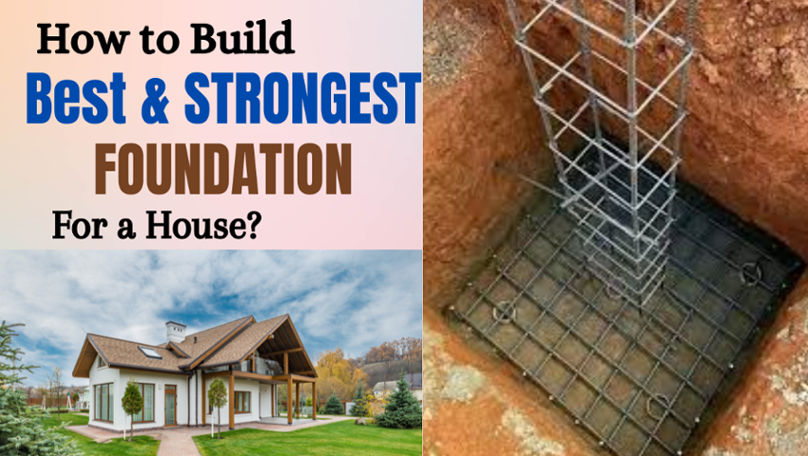Here you’ll know about the best foundation for house construction. When our house was being built, there were mistakes I recognized. But the contractor and mistri were ignoring them. I immediately put my words and corrected the foundation and Footing mistakes. I realized that the owners have no idea about the foundation work. And the worst part is they didn’t discuss this.
Most of the house owners only focus on the architectural work. They ignore the strongest foundation work. So here I have put some points to know before mistakes happen on the footing part of your house. Here I’ll outline the types of foundation, which type of soil, and what type of Footing will be suitable.
General Footing in Foundation in the house construction
There are many step-by-step house construction processes and all it start from the foundation. Most of the houses start using this kind of footing. It is named Isolated Column Footing or Shallow Foundations in Construction. it is considered one of the best foundation for house construction which is suitable on average for all kinds of soil.
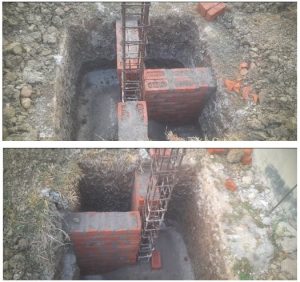
Steps to follow When foundation works begin. Here from point Number 1 to 16 Explained from the bottom to top of the Plinth Beam.
- Marking- Marking the site with Chuna (Quick Lime) according to the layout and the pillars.
- Excavation– Manual or with the JCB (5 X 5 width and Length) using 5 ft deep from the surface level.
- Dressing– Using JCB it is not clean so going through manually gives a sharp cubic-sized trench.
- Sand Filling- Use Local sand or standard sand up to 3-inch.
- Brick Soiling- Up to 3-inch brick flat soling
- PCC (plan cement concrete)– 4-inch PCC M10 Garde (1: 3:6 ) uses the aggregate 40 mm size.
- Column Center Line Marking- Very Important where the Center is lying according to the Ring size.
- Footing Net- Prepared footing net using 10 mm size bars with a space of 6 inches.
- Pillar cage- Above the Footing net and the tie with wires in the L sections
- Casting of Footing – Casting of footing including the pillar cage with footing net using M20 grade ( 1: 1.5 : 3)
- Shuttering of – Shuttering is Done or the brick pillars and then concreting
- Brickwork from the foundation- From a depth of 5 Feet and resting on footing, the brickwork is started which meets the beam. (Shown in the above picture)
- Sloping of footing- The slope of 1’6’’ is done to make the trapezium shape above the footing.
- Pillar shuttering- Up to the bottom of beam level and then casting.
- Backfilling- The left part of the excavation area should be filled with local sand or the excavated soil pieces.
- Water Curing– Curing is done in every stage.
How to Make the Foundation Stronger?
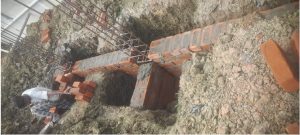
You can see in the pictures above how the brickwork is started from the foundation. After brickwork, the pillar will be cast with cement concrete. so, this kind of foundation is stronger for 2 or 3-story buildings.
Selecting a Type of Foundation from Different Types of Soil?
The selection of foundation type depends on the following things-
- A total load of the building coming on the structure
- Type of soil
- Water table level
- Adjoining structure
In this, types of soil play an important factor. So Here, we’ll talk about the soils and which type of foundation will be good for the respective soil.
Clay soil
Let us discuss clay soil clay first.
When Clay is exposed to moisture it expands and shrinks significantly. When it is dry, The Foundation structure can suffer from great settlement and uplift pressure will adversely affect the building structure. That’s why This soil is not desirable.
Raft or Mat foundation is the best foundation type to be built on clay soil. Somehow The Raft Foundation is costly and more cement Concrete and steel are required. But if the loads from the superstructure are high or a strong soil layer is not available at shallow depth, then under reamed pile Foundation should be selected for this kind of soil.
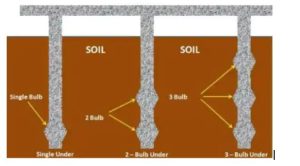
In the case of clay soil, a Pier beam Foundation can also be used. In the pier foundation, beams are connected and peers are going inside the ground. There is some space between the beam and the Crown which is called a crawl space.
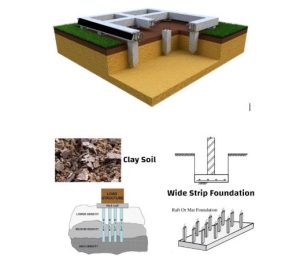
If trees, Hedges, and shrubs are close to the Foundation location or there are trees near the structure in the future, then a Pile Foundation carrying an in-situ concrete slab can be used.
In short, for clay soil, wide strip Foundation (in the above picture), raft foundation, and pile Foundation can be used.
Peat soil
Peat soil peat soil is considerably
- Porous
- Easily compressible and
- Dark brown or black color soil
Peat soil is commonly present near wetlands. it undergoes expansion and shrinkage due to moisture fluctuation. It is extremely weak in terms of Load-carrying capacity.
so, in some cases when the peat layer is at a shallow depth, it can be removed up to strong strata and replaced with Engineered fills, and a Strip Foundation can be used.
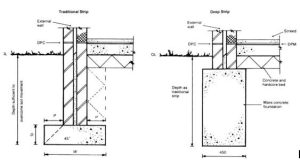
If the thickness of peat soil is great and its removal is not economical then Pile Foundation should be selected for small projects.
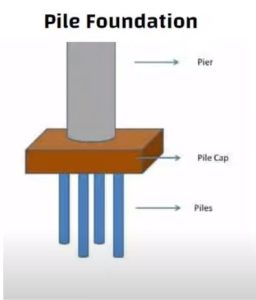
Silty Soil
Silty soil can be smooth to touch and retain water for longer periods because of its smaller particles. It is generally not suitable for foundation structure because of its expansion which exerts pressure against foundation and damage.
It drains water easily if firm silt or firm silty clay deposit extending to a grid depth is available then RCC spread and Isolated Pad footing are appropriate.
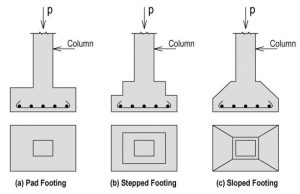
Gravel
In the case of dry compact gravel, parade, and strip foundations can be used.
if gravel is submerged in water the bearing capacity is declined by half. In this case, shallow RCC White Strip Foundation can be used.
Sand soil- If sand is damp compacted and uniform holds together reasonably well but trenches May collapse. so, sheet piling is often used to retain the ground in trenches until the concrete is poured in sand.
if node sand is extended for great depth then it is recommended to compact it and use spread footing alternatively. Raft-driven piles or augured piles can be selected without the use of compaction energy in desert soils. multi-storage buildings usually have pile foundations especially driven piles or augard casting situ piles.
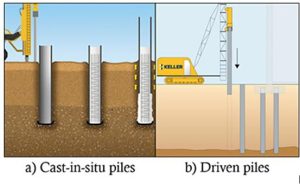
Loam soil

loam is a combination of clay silt and sand.
It is dark in color, soft, dry, and crumbly to the touch. loam is the best option to support the Foundation because of its uniformly balanced characteristics.
it maintains water at a balanced rate and hence neither shrinks nor expands to an extent that can damage foundations. Isolated footing is the most desired type of foundation for loam soil.
Mountain soil
Mountain soils and Forest soils are most likely to have Boulders at various depths. so pile foundations are not suitable here for residential buildings with one or two floors isolated RCC pad footings are suitable. no residential buildings should be constructed on slopes steeper than 25 degrees.
Rock Soil
Rock soil involves Bedrock Sandstone.
Shale hard chalk and limestone Rock soil have excellent stability High bearing capacity and great resistance to water damage.
As long as the rock is labeled and the foundation is well supported the most suitable foundations for rock soil are the strip Foundation, pad foundation, and raft Foundation. Make sure. in the Strip Foundation, the foundation shall be kept above the groundwater table.
How deep should be the Foundation of a Building
It all depends on the type of soil on the Existing site location. if there is a hard stratum, 5 Feet Deep is enough to start the footing work.
And, If the Strata is loose or the water table is high, then at least 7 feet deep has to be excavated from the Ground Beam.
What are important Soil Tests in the foundation?
Before starting construction, it is important to perform soil testing. If you’re constructing a high-rise building, you have to prefer the Soil Test.
Here, The following tests are standard.
Soil Investigation Test
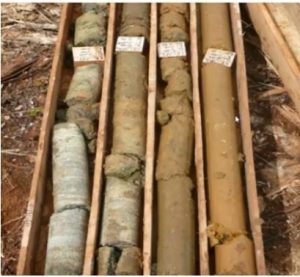
This test is conducted to know the soil’s Physical, chemical, and mechanical properties.
Samples are collected and sent for lab tests. After performing the test, the engineers know the Bearing Capacity and the Physical and Chemical nature of the land.
Plate Load Test/ Standard Penetration test
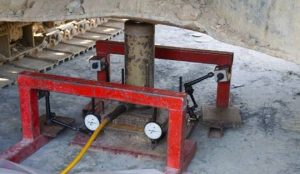
if you’re building a G5-story building then the structure engineer demands the load-bearing capacity test.
Soil Analysis (Sampling test)
For this test, a sample has been collected from the site to know the soil’s suitability for backfilling. This test analysis includes Atterberg’s limits, organic variation, and sieve analysis.
Conclusion
This Blog has given you some ideas to decide the best foundation for house construction on your site and what footing to decide. keep each detail in mind and tell the contractors to choose the best footing. This could save you the most money and reduce the risk of damage to any building structure.
FAQ (Frequently Asked Question)
What is the best foundation for Clay soil?
Answer- Raft or Mat Foundation is the best in clay soil because of the greater load-bearing capacity.
What are important Soil Tests in the foundation?
Answer- Plate Load test, and soil excavation test are important tests to do before the foundation work.

